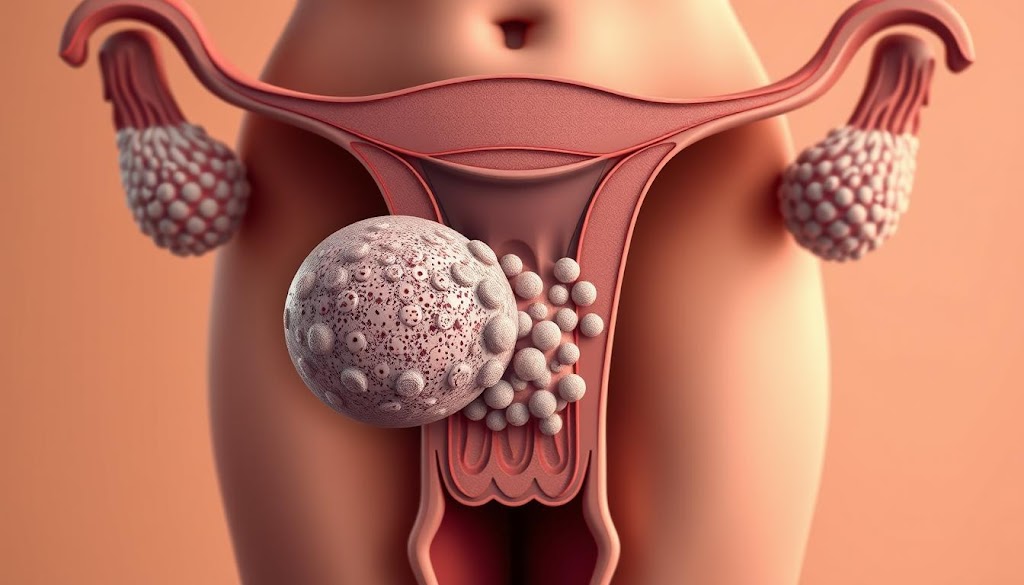Cancer of the Womb: Symptoms, Causes, and Treatment
Cancer of the womb, also known as endometrial cancer or uterine cancer, is a big worry for women in South Africa. It happens in the uterus and can be treated if caught early. Knowing the signs, like unusual vaginal bleeding, and what causes it is key to getting the right treatment. Endometrial and uterine cancer are terms for cancer of the womb.
Uterine and endometrial cancer are cancers that hit the uterus. They can be treated with surgery, radiation, and chemo. Finding cancer early is the best way to treat it.
Endometrial and uterine cancer are serious health matters that need attention and awareness. Knowing the symptoms, causes, and treatments helps women take charge of their health. With the right care, cancer of the womb, including endometrial and uterine cancer, can be managed.
Introduction to Cancer of the Womb
Endometrial and uterine cancer are cancers that hit the uterus. Knowing the symptoms and causes of womb cancer is key for early detection and treatment. These cancers can be treated with surgery and radiation therapy.
Key Takeaways
Endometrial cancer and uterine cancer are types of cancer that affect the uterus
Cancer of the womb can be treated with surgery, radiation therapy, and chemotherapy
Early detection is key to effective treatment of endometrial cancer and uterine cancer
Understanding the symptoms and causes of cancer of the womb is crucial for early detection
Uterine cancer and endometrial cancer can be managed with the right treatment and support
Cancer of the womb is a significant health concern for women in South Africa
Understanding Cancer of the Womb
Cancer of the womb, also known as uterine cancer, affects the uterus. It’s important to know the basics to prevent and detect it early. Recognizing the symptoms of womb cancer is key, as they can be subtle and similar to other health issues. Knowing the causes of uterine cancer is also vital, as some factors can raise your risk.
There are different types of uterine cancer, like endometrioid carcinoma, serous carcinoma, and clear cell carcinoma. Each type has its own traits and outcomes. The treatment for endometrial cancer depends on the type and stage. If symptoms persist or get worse, it’s crucial to see a doctor.
Age: The risk goes up with age, especially after menopause.
Obesity: Being overweight or obese can increase the risk.
Family history: A family history of cancer can also raise your risk.
Knowing these factors can help you take steps to prevent it. If you notice anysymptoms of womb cancer, seek medical help.
Early Warning Signs and Symptoms
It’s important to know the early signs of womb cancer for quick medical help and diagnosis of uterine cancer. Look out for abnormal vaginal bleeding. This can be bleeding between periods, heavier or longer periods, or bleeding after menopause. You might also feel pelvic pain, have trouble urinating, or feel pain during sex.
If these symptoms keep happening, see a healthcare provider right away. They can check you out and look for signs of endometrial cancer. Some important symptoms to watch for are:
Unusual vaginal discharge or odor
Pelvic pain or pressure
Difficulty starting or stopping urination
Pain during intercourse
Don’t wait if you have these symptoms. Early treatment can make a big difference. A doctor will do a physical exam, ask about your health history, and might do tests. This helps figure out what’s going on and if you have diagnosis of uterine cancer.
Knowing the early signs of womb cancer can help you stay healthy. If you notice anything odd, talk to a healthcare provider. They can help and support you.
Common Causes and Risk Factors
Knowing what causes uterine cancer is key to preventing it. There are many risk factors for endometrial cancer, including genetics, lifestyle, and medical conditions. To lower womb cancer risk, it’s important to know how to prevent it and understand its causes.
Many things can lead to womb cancer. Genetic factors, like Lynch syndrome, play a part. Lifestyle choices, like being overweight or not exercising, also matter. Medical conditions, such as PCOS, diabetes, and high blood pressure, raise the risk too.
Key Risk Factors
Genetic mutations, such as Lynch syndrome
Obesity and lack of physical activity
Hormone replacement therapy
Polycystic ovary syndrome (PCOS)
Diabetes and high blood pressure
Knowing these risk factors helps in preventing and catching endometrial cancer early. Regular health checks, a healthy lifestyle, and knowing about uterine cancer can greatly lower the risk of womb cancer.
How Doctors Diagnose Womb Cancer
Doctors start by doing a physical exam and looking at your medical history. This helps them find out if you might have cancer. Finding womb cancer takes several steps, including imaging tests and biopsies.
Imaging tests like ultrasound and CT scans help doctors see the uterus. These tests can spot problems in the uterine tissue. Sometimes, a biopsy is needed to take a tissue sample from the uterus.
A dilation and curettage (D&C) procedure might also be used. It lets doctors take tissue samples from the uterus. These samples are checked for cancer cells. This way, doctors can figure out if you have cancer and what kind it is.
Some common ways to diagnose womb cancer include:
Physical exam and medical history
Imaging tests (ultrasound, CT scans, MRI scans)
Biopsy
Dilation and curettage (D&C) procedure
These methods help doctors find out if you have cancer, what type it is, and how far it has spread. This information helps doctors plan the best treatment for you.
Stages of Endometrial Cancer
Knowing the stages of endometrial cancer is key to finding the right treatment. The stages range from I to IV, with I being the least severe and IV the most advanced. Getting the cancer’s stage right is crucial for planning the best treatment for uterine cancer.
The stages of endometrial cancer depend on how far the cancer has spread. The earlier the stage, the better the outlook. Here’s a breakdown of the stages:
Stage I Through IV Explained
Stage I: Cancer is confined to the uterus.
Stage II: Cancer has spread to the cervix.
Stage III: Cancer has spread to the pelvis or lymph nodes.
Stage IV: Cancer has spread to distant parts of the body.
Each stage has its own treatment options. For instance, stage I cancer might just need surgery. But more advanced stages might need surgery, radiation, and chemotherapy. The treatment for uterine cancer changes a lot with each stage, so getting the stage right is vital.
Understanding the stages of endometrial cancer and their treatment options helps patients make better choices. It’s important to work with a healthcare team to find the best treatment for each person.
Treatment Options and Approaches
When it comes to treatment options for endometrial cancer, the choice depends on the cancer’s stage and type. It also depends on the patient’s overall health. The main goal of uterine cancer treatment is to remove the cancer and stop it from coming back.
Treatment options include surgery, radiation therapy, chemotherapy, and hormone therapy. Surgery is often the first choice, especially for early-stage cancer. It may involve removing the uterus and lymph nodes.
Other treatment options include:
Radiation therapy, which uses high-energy rays to kill cancer cells and can be used before or after surgery
Chemotherapy, which involves drugs that kill cancer cells and is typically used for more advanced stages
Hormone therapy, which may be used for cancers that are hormone-receptor positive
The choice of uterine cancer treatment is tailored to each patient. It considers the cancer’s specific characteristics and the patient’s health and preferences. By understanding the different treatment options for endometrial cancer, patients can make informed decisions. They can work with their healthcare team to create a personalized treatment plan.
Surgery and Recovery Process
When dealing with surgery for uterine cancer, the main aim is to remove the cancer. This is done while keeping as much healthy tissue as possible. The surgery type depends on the cancer’s stage and type.
Before surgery, patients go through a detailed evaluation. This helps decide the best treatment plan. This might include a hysterectomy, which could also involve removing ovaries and lymph nodes.
Types of Surgical Procedures
Open incision surgery
Minimally invasive techniques, such as laparoscopy
Post-Surgery Care
After surgery, patients need close monitoring and care. This is to manage pain, prevent infection, and aid in healing. Care might include medication, physical therapy, and regular check-ups with the doctor.
Expected Recovery Timeline
The recovery from endometrial cancer surgery varies by individual and surgery type. Generally, patients need several weeks of rest. They then gradually return to their normal activities.
Living with a Womb Cancer Diagnosis
Getting a cancer diagnosis can change your life. It’s key to know that living with endometrial cancer means more than just treatment. It’s about emotional support and making lifestyle changes. Patients need to find ways to coping with uterine cancer by talking to loved ones, joining support groups, or seeing mental health experts.
Emotional Support
Emotional support is vital when facing cancer. It can be found in many ways, such as:
Talking to a therapist or counselor
Joining a support group
Connecting with friends and family
These options can offer comfort and help patients deal with the emotional side of living with endometrial cancer.
Lifestyle Adjustments
Changing your lifestyle is also important when coping with uterine cancer. This might mean eating better, exercising more, or finding ways to handle stress. A healthy lifestyle can help manage treatment side effects and boost overall health.
By getting emotional support and making lifestyle changes, patients can find ways to thrive with living with endometrial cancer and coping with uterine cancer. Remember, everyone’s journey is different. But with the right support, patients can get through this tough time and live better.
Prevention Strategies
To prevent uterine cancer, several steps can be taken. Keeping a healthy weight is key. This is done through a balanced diet and regular exercise. It helps control hormone levels and boosts overall health, lowering the risk of endometrial cancer.
Changing your lifestyle can also help. For instance, avoiding hormone replacement therapy or using it for the shortest time possible is beneficial. Also, managing health issues like diabetes and high blood pressure is important.
Here are some ways to lower the risk of endometrial cancer:
Maintain a healthy weight
Exercise regularly
Avoid hormone replacement therapy
Manage underlying medical conditions
By living a healthy lifestyle and knowing the risks, you can take steps to prevent uterine cancer and reduce the risk of endometrial cancer. It’s vital to talk to a healthcare professional for advice on prevention and early detection.
Support Resources in South Africa
In South Africa, people with womb cancer have many support options. These include medical centers, support groups, and financial help. These resources are key for getting the best care and emotional support.
For uterine cancer support in South Africa, many medical places offer special care. Some of these places are:
Major hospitals with oncology departments
Cancer treatment centers with advanced technology
Private clinics with specialized gynecological oncologists
Support groups are also crucial for emotional support and community. They can be found online or in-person. These groups let people share their stories and connect with others facing similar challenges.
There are also financial programs to help with treatment costs. These programs cover medical bills, travel, and more. Knowing where to find these resources helps people focus on getting better, not worrying about money.
Overall, having uterine cancer support in South Africa and endometrial cancer resources is very important. They offer care, emotional support, and financial help. This makes a big difference in the lives of those with womb cancer, helping them through their journey.
Conclusion
As we wrap up our look at cancer of the womb, or endometrial cancer, it’s clear that awareness and early detection are key. By spotting early signs and knowing the uterine cancer risk factors, women in South Africa can protect their health.
Understanding the need for regular check-ups and screenings is crucial. So is making healthy lifestyle choices. Each of us has a role in fighting cancer of the womb. With knowledge and support, we can face this challenge with hope and confidence.
Early detection is vital, and acting quickly can improve outcomes. Use the resources available, connect with support groups, and watch your health closely. Together, we can make cancer of the womb a manageable condition for women in South Africa.
FAQ
What is endometrial cancer?
Endometrial cancer starts in the lining of the uterus, known as the endometrium.
What are the different types of uterine cancer?
Uterine cancer types include endometrioid carcinoma, serous carcinoma, and clear cell carcinoma. Each has its own characteristics and outcomes.
Who is at risk of developing uterine cancer?
Risk factors for uterine cancer include age, obesity, family history, and previous radiation therapy.
What are the early warning signs and symptoms of womb cancer?
Symptoms of womb cancer include abnormal bleeding, pelvic pain, and difficulty urinating. Pain during sex is also common.
What causes cancer of the womb?
Womb cancer causes include genetics, lifestyle factors like obesity, and certain medical conditions. These include polycystic ovary syndrome and diabetes.
How is womb cancer diagnosed?
Diagnosing womb cancer involves a physical exam, medical history, and imaging tests. A biopsy confirms the cancer’s presence and type.
What are the stages of endometrial cancer?
Endometrial cancer stages range from I to IV. Stage I is the least severe, and stage IV is the most advanced. The stage guides treatment.
What are the treatment options for womb cancer?
Womb cancer treatment includes surgery, radiation, chemotherapy, and hormone therapy. The choice depends on the cancer’s stage and type.
What can I expect from the surgery and recovery process?
Surgery specifics, recovery time, and post-surgery care vary. Patients need rest and time to gradually return to normal activities.
How can I cope with a womb cancer diagnosis?
Emotional support, lifestyle changes, and connecting with others help cope with womb cancer. It’s important to seek support and make adjustments.
How can I reduce my risk of developing womb cancer?
Reducing womb cancer risk involves maintaining a healthy weight, using birth control pills, and managing medical conditions. Regular check-ups and awareness are key.
What support resources are available in South Africa for womb cancer patients?
In South Africa, womb cancer patients can find support through medical facilities, support groups, and financial programs. These help with treatment and management.



